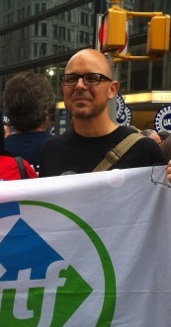 It was the week that saw the biggest global action on climate change ever. Our guest blogger: David Hansen-Miller, ITF strategic researcher, reports from New York.
It was the week that saw the biggest global action on climate change ever. Our guest blogger: David Hansen-Miller, ITF strategic researcher, reports from New York.
“I spent a long weekend in NYC working with Trade Unions for Energy Democracy. On Saturday people were hopeful about the People’s Climate March but still didn’t know what to expect. On Sunday we were overwhelmed by the crowds. It was a sea of people that clearly exceeded everyone’s expectations. The trade unionists made a good showing and while everyone leaves inspired, no one is unclear about the hard work in front of us. Here is my account of what took place...
Between the 20th and the 22nd of September, the ITF and members from affiliates (ATU, SEIU, GMB, UNIFOR, CUPE, PCS, TWU, NUMGE) gathered with other unions, global union federations, and national centres for three days of events with Trade Unions for Energy Democracy (TUED).
On Saturday the 20th, the day before the massive People’s Climate March, over 70 representatives from more than 15 unions, as well as allies in the environmental movement, packed out Cornell University’s ILR New York City conference centre to discuss trade union strategies for responding to climate change. The focus was on changing the political narrative from exploitative and failing market responses and or unrealizable technological fixes to the problem. Instead, the group focused on further development of climate justice where the economic foundations of the crisis could be both recognized and effectively fought.
Jumping off from the TUED position paper ‘Climate Change and the Great Inaction’, participants discussed the integral relationship between neo-liberalism, the market economy, privatized resources, and inaction on the climate crisis. Representatives discussed the increasingly obvious ways in which working people are hit the hardest by the effects of climate change, both at work and at home. The failure of private companies to cut emissions or spend money on the necessary public and social infrastructure demanded by the crises, means that nothing is being done to stop catastrophe or to protect workers from its impact. Workers are having to do more to respond to the crises, with less social resources at their disposal. Representatives from the nurses’ unions and janitors’ unions of the New York area spoke persuasively about the impact Hurricane Sandy had on working people, how this had pushed climate change up their union agenda, as well as the ways in which it had made it easier to productively engage with people on the issue as the relationship between economic justice and climate justice could no longer be avoided.
Session participants were generally agreed that the problem was not really a question of vision. In fact, participants were clear the TUED had provided a strong alternate narrative (‘Resist, Reclaim, Restructure’) to the current lack of action on climate change. The issue was now how to focus organising efforts that put workers and trade unions at the forefront of solutions to the climate change crisis.
The meeting, joined for a period by author and activist Naomi Klein, went onto discuss questions of a ‘just transition’ to a green economy. Energy union representatives spoke about their ideas for backing divestment from the carbon economy and transitioning workers to good jobs in renewable energy. Research was presented on the pros and cons of supporting energy cooperatives. Public service trade unionist discussed the potentials of focusing organising climate change groups across unions in urban areas, where power and influence can be exercised over local governments. Similarly, the twinning of urban areas was discussed as a possibility for expanding international cooperation around green alternatives. There was discussion of fighting privatisation and successful as well as failed strategies for ‘re-municipalisation’ of energy and water. Similarly, members were buoyed by reports from environmental movement representatives about the increasingly necessary emphasis on economic justice within the movement and the prospects for greater bonds with labour.
As the day ended and reports about march preparations came in, hopes for the People’s Climate March grew.
On the day, the labour contingent gathered at Columbus Circle for a rally at 10:30 and a place near the front of the march. Along with others, locals from the SEIU, the Teamsters, the ATU, and the TWU were all out in force, helping to make up numbers over 300,000
Even the American business magazine Fortune stood up and took notice of organised labour’s showing at the march.
On Monday the 22nd, the Trade Unions for Energy Democracy group started early with a post-march breakfast and leadership meeting between TUED participants and New York Unions, hosted by SEIU Building Janitors, and United Health Care Workers East (1199).
The discussions from Saturday were followed up with new ideas, new optimism and renewed energy in the aftermath of the largest ever climate change demonstration. Different speakers emphasized the need to seize the opportunity and further drive home the understanding that climate justice and economic justice are one and the same.
A second meeting was hosted by TUED and the Rosa Luxemburg Stiftung New York office, where international participants discussed ‘where next’ for Trade Unions for Energy Democracy. Question of better trade union support were discussed as well as whether or not the network should be more formalized. Participants felt the boost from the march should facilitate greater take up of TUED’s approach among both leadership and mass membership if everyone could continue working to develop specific organising objectives. After the meeting, some participants joined “Flood Wall Street.”
The three days were concluded in the evening with a celebration of the march at SEIU 1199’s auditorium in midtown Manhattan where the New York members presented the international guests with gifts.
Click here to read the ITF news story: unions join global calls for climate change action.
Leave a Reply